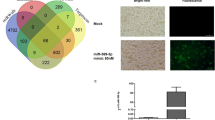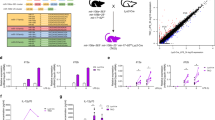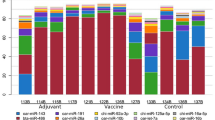Abstract
miR-126 is a microRNA expressed predominately by endothelial cells and controls angiogenesis. We found miR-126 was required for the innate response to pathogen-associated nucleic acids and that miR-126-deficient mice had greater susceptibility to infection with pseudotyped HIV. Profiling of miRNA indicated that miR-126 had high and specific expression by plasmacytoid dendritic cells (pDCs). Moreover, miR-126 controlled the survival and function of pDCs and regulated the expression of genes encoding molecules involved in the innate response, including Tlr7, Tlr9 and Nfkb1, as well as Kdr, which encodes the growth factor receptor VEGFR2. Deletion of Kdr in DCs resulted in reduced production of type I interferon, which supports the proposal of a role for VEGFR2 in miR-126 regulation of pDCs. Our studies identify the miR-126–VEGFR2 axis as an important regulator of the innate response that operates through multiscale control of pDCs.
This is a preview of subscription content, access via your institution
Access options
Subscribe to this journal
Receive 12 print issues and online access
$209.00 per year
only $17.42 per issue
Buy this article
- Purchase on Springer Link
- Instant access to full article PDF
Prices may be subject to local taxes which are calculated during checkout







Similar content being viewed by others
Accession codes
References
McCartney, S.A. & Colonna, M. Viral sensors: diversity in pathogen recognition. Immunol. Rev. 227, 87–94 (2009).
Kawai, T. & Akira, S. Toll-like receptors and their crosstalk with other innate receptors in infection and immunity. Immunity 34, 637–650 (2011).
Chevrier, N. et al. Systematic discovery of TLR signaling components delineates viral-sensing circuits. Cell 147, 853–867 (2011).
Yang, K. et al. Human TLR-7-, -8-, and -9-mediated induction of IFN-α/β and -λ is IRAK-4 dependent and redundant for protective immunity to viruses. Immunity 23, 465–478 (2005).
Kumar, H., Kawai, T. & Akira, S. Toll-like receptors and innate immunity. Biochem. Biophys. Res. Commun. 388, 621–625 (2009).
Baltimore, D. et al. MicroRNAs: new regulators of immune cell development and function. Nat. Immunol. 9, 839–845 (2008).
Bartel, D.P. MicroRNAs: target recognition and regulatory functions. Cell 136, 215–233 (2009).
Taganov, K.D., Boldin, M.P., Chang, K.-J. & Baltimore, D. NF-κB-dependent induction of microRNA miR-146, an inhibitor targeted to signaling proteins of innate immune responses. Proc. Natl. Acad. Sci. USA 103, 12481–12486 (2006).
O'Connell, R.M. et al. MicroRNA-155 is induced during the macrophage inflammatory response. Proc. Natl. Acad. Sci. USA 104, 1604–1609 (2007).
Brown, B.D. et al. Endogenous microRNA can be broadly exploited to regulate transgene expression according to tissue, lineage and differentiation state. Nat. Biotechnol. 25, 1457–1467 (2007).
O'Connell, R.M., Chaudhuri, A.A., Rao, D.S. & Baltimore, D. Inositol phosphatase SHIP1 is a primary target of miR-155. Proc. Natl. Acad. Sci. USA 106, 7113–7118 (2009).
Zhou, H. et al. miR-155 and its star-form partner miR-155* cooperatively regulate type I interferon production by human plasmacytoid dendritic cells. Blood 116, 5885–5894 (2010).
O'Neill, L.A., Sheedy, F.J. & McCoy, C.E. MicroRNAs: the fine-tuners of Toll-like receptor signalling. Nat. Rev. Immunol. 11, 163–175 (2011).
Fish, J.E. et al. miR-126 regulates angiogenic signaling and vascular integrity. Dev. Cell 15, 272–284 (2008).
Kuhnert, F. et al. Attribution of vascular phenotypes of the murine Egfl7 locus to the microRNA miR-126. Development 135, 3989–3993 (2008).
Wang, S. et al. The endothelial-specific microRNA miR-126 governs vascular integrity and angiogenesis. Dev. Cell 15, 261–271 (2008).
Brown, B.D. et al. In vivo administration of lentiviral vectors triggers a type I interferon response that restricts hepatocyte gene transfer and promotes vector clearance. Blood 109, 2797–2805 (2007).
Beignon, A.-S. et al. Endocytosis of HIV-1 activates plasmacytoid dendritic cells via Toll-like receptor-viral RNA interactions. J. Clin. Invest. 115, 3265–3275 (2005).
Meylan, P.R., Guatelli, J.C., Munis, J.R., Richman, D.D. & Kornbluth, R.S. Mechanisms for the inhibition of HIV replication by interferons-α, -β, and -γ in primary human macrophages. Virology 193, 138–148 (1993).
Reizis, B., Bunin, A., Ghosh, H.S., Lewis, K.L. & Sisirak, V. Plasmacytoid dendritic cells: recent progress and open questions. Annu. Rev. Immunol. 29, 163–183 (2011).
Colonna, M., Trinchieri, G. & Liu, Y.-J. Plasmacytoid dendritic cells in immunity. Nat. Immunol. 5, 1219–1226 (2004).
Naik, S.H. et al. Development of plasmacytoid and conventional dendritic cell subtypes from single precursor cells derived in vitro and in vivo. Nat. Immunol. 8, 1217–1226 (2007).
Cella, M. et al. Plasmacytoid monocytes migrate to inflamed lymph nodes and produce large amounts of type I interferon. Nat. Med. 5, 919–923 (1999).
Asselin-Paturel, C. et al. Type I interferon dependence of plasmacytoid dendritic cell activation and migration. J. Exp. Med. 201, 1157–1167 (2005).
Vitour, D. & Meurs, E.F. Regulation of interferon production by RIG-I and LGP2: a lesson in self-control. Sci. STKE 2007, pe20 (2007).
Miller, J.C. et al. Deciphering the transcriptional network of the dendritic cell lineage. Nat. Immunol. 13, 888–899 (2012).
Krug, A. et al. IFN-producing cells respond to CXCR3 ligands in the presence of CXCL12 and secrete inflammatory chemokines upon activation. J. Immunol. 169, 6079–6083 (2002).
Li, H.S. et al. The signal transducers STAT5 and STAT3 control expression of Id2 and E2–2 during dendritic cell development. Blood 120, 4363–4373 (2012).
van de Laar, L. et al. PI3K-PKB hyperactivation augments human plasmacytoid dendritic cell development and function. Blood 120, 4982–4991 (2012).
Cao, W. et al. Toll-like receptor-mediated induction of type I interferon in plasmacytoid dendritic cells requires the rapamycin-sensitive PI(3)K-mTOR-p70S6K pathway. Nat. Immunol. 9, 1157–1164 (2008).
Quinn, T.P., Peters, K.G., De Vries, C., Ferrara, N. & Williams, L.T. Fetal liver kinase 1 is a receptor for vascular endothelial growth factor and is selectively expressed in vascular endothelium. Proc. Natl. Acad. Sci. USA 90, 7533–7537 (1993).
Carmeliet, P. & Jain, R.K. Molecular mechanisms and clinical applications of angiogenesis. Nature 473, 298–307 (2011).
Ding, B.-S. et al. Inductive angiocrine signals from sinusoidal endothelium are required for liver regeneration. Nature 468, 310–315 (2010).
Ghosh, H.S., Cisse, B., Bunin, A., Lewis, K.L. & Reizis, B. Continuous expression of the transcription factor e2–2 maintains the cell fate of mature plasmacytoid dendritic cells. Immunity 33, 905–916 (2010).
Grouard, G. et al. The enigmatic plasmacytoid T cells develop into dendritic cells with interleukin (IL)-3 and CD40-ligand. J. Exp. Med. 185, 1101–1111 (1997).
Siegal, F.P. et al. The nature of the principal type 1 interferon-producing cells in human blood. Science 284, 1835–1837 (1999).
Stepkowski, S.M., Chen, W., Ross, J.A., Nagy, Z.S. & Kirken, R.A. STAT3: an important regulator of multiple cytokine functions. Transplantation 85, 1372–1377 (2008).
Plas, D.R. & Thomas, G. Tubers and tumors: rapamycin therapy for benign and malignant tumors. Curr. Opin. Cell Biol. 21, 230–236 (2009).
Guiducci, C. et al. PI3K is critical for the nuclear translocation of IRF-7 and type I IFN production by human plasmacytoid predendritic cells in response to TLR activation. J. Exp. Med. 205, 315–322 (2008).
Conrad, C. et al. Plasmacytoid dendritic cells promote immunosuppression in ovarian cancer via ICOS costimulation of Foxp3+ T-regulatory cells. Cancer Res. 72, 5240–5249 (2012).
Ferrara, N., Mass, R.D., Campa, C. & Kim, R. Targeting VEGF-A to treat cancer and age-related macular degeneration. Annu. Rev. Med. 58, 491–504 (2007).
Nestle, F.O. et al. Plasmacytoid predendritic cells initiate psoriasis through interferon-alpha production. J. Exp. Med. 202, 135–143 (2005).
Lande, R. et al. Plasmacytoid dendritic cells sense self-DNA coupled with antimicrobial peptide. Nature 449, 564–569 (2007).
Guiducci, C. et al. Autoimmune skin inflammation is dependent on plasmacytoid dendritic cell activation by nucleic acids via TLR7 and TLR9. J. Exp. Med. 207, 2931–2942 (2010).
Diana, J. et al. Crosstalk between neutrophils, B-1a cells and plasmacytoid dendritic cells initiates autoimmune diabetes. Nat. Med. 19, 65–73 (2013).
Banchereau, J. & Pascual, V. Type I interferon in systemic lupus erythematosus and other autoimmune diseases. Immunity 25, 383–392 (2006).
Wang, H., Peng, W., Ouyang, X., Li, W. & Dai, Y. Circulating microRNAs as candidate biomarkers in patients with systemic lupus erythematosus. Transl. Res. 160, 198–206 (2012).
Janssen, H.L.A. et al. Treatment of HCV infection by targeting microRNA. N. Engl. J. Med. 368, 1685–1694 (2013).
O'Connell, R.M. et al. MicroRNA-155 promotes autoimmune inflammation by enhancing inflammatory T cell development. Immunity 33, 607–619 (2010).
Agudo, J. et al. A TLR and non-TLR mediated innate response to lentiviruses restricts hepatocyte entry and can be ameliorated by pharmacological blockade. Mol. Ther. 20, 2257–2267 (2012).
Acknowledgements
We thank C.J. Kuo (Stanford University) for Mir126−/− mice; P. Sathe, R. Sachidanandam, L. Naldini and B. Gentner for discussions; J. Ochando for reading the manuscript; and the Mount Sinai Mouse Genetics and Mouse Targeting facility, the Flow Cytometry Core and the Mount Sinai Genomics Core for technical assistance. Supported by the US National Institutes of Health (DP2DK083052 and 1R01AI104848 to B.D.B., and CA154947A, AI10008 and AI089987 to M.M.), the Beatriu de Pinós program (J.A.), and the Juvenile Diabetes Research Foundation (J.A.).
Author information
Authors and Affiliations
Contributions
J.A. designed and did research and analyzed data; A.R., N.T., H.S., M.L., D.H., C.B., L.-A.G.-S. and A.B. did research; M.M. designed the project and analyzed data; and B.D.B. designed and coordinated the project and analyzed data.
Corresponding author
Ethics declarations
Competing interests
The authors declare no competing financial interests.
Integrated supplementary information
Supplementary Figure 1 Kinetics of the innate response to CpG DNA in WT and Mir126−/− mice.
(a) Measurement of serum IFN-a at the indicated time points after injection of CpG-A 2216 (4 μg) + DOTAP. Results are the mean±SD (n=3). (b) Measurement of serum IL-6 at the indicated time points after injection of CpG-A 2216 (4 μg) + DOTAP. Results are the mean±SD (n=3).
Supplementary Figure 2 Tlr7 and Tlr9 expression across the immune system and relative miRNA expression in different DC subsets.
(a) Tlr7 and Tlr9 expression pattern across the immune system as determined by the Immgen Consortium. Expression of each gene was measured by Affymetrix gene array on 234 different populations of immune cells that were double sorted to high purity. Shown is the mean±SD (n≥3). Note that the stroma includes both lymphatic and blood endothelial cells isolated from mesenteric lymph node. (b) Table showing miRNAs with the largest difference in expression between pDCs and the other DC subsets studied. Expression was determined by qPCR after sorting the indicated cells. The average fold difference (n=3-5) in expression of the indicated miRNA in pDCs compared to CD4+ DCs, CD8+ DCs, and CD103+ DCs was calculated by the ΔΔCT method.
Supplementary Figure 3 Loss of miR-126 impairs pDC homeostasis.
Eight week old Mir126-/- mice and WT littermates were analyzed. Representative flow cytometry plotsare shown. (a) CD4+ DC and CD8+ DC and B cells in the spleen. (b) CD4+ T cells and CD8+ T cells in the spleen. (c) (i) Eosinophils (Eos), (ii) neutrophils (Neut) and (iii) Gr1hi monocytes (mo) and (iv) Gr1low mo in the spleen.
Supplementary Figure 4 pDC proliferation is not affected by the loss of miR-126.
pDCs were differentiated in vitro from BM progenitors of Mir126-/- mice or WT littermate controls. pDC proliferation was measured by staining the cells with eFluor670 dye, and measuring dye dilution by flow cytometry at the indicated time points. (a) Shown are representative histograms gated on alive pDCs (DAPI- CD11c+ B220+ PDCA1+ cells) and all alive cells in the culture (DAPI-). (b) The graphs present the mean±SD (n=3-4).
Supplementary Figure 5 VEGFR2 is expressed in pDCs and can be downregulated in Kdrfl mice by Itgax-Cre expression.
(a) Protein expression of surface VEGFR2 in splenic pDCs was measured by flow cytometry. Note that VEGFR2 positive cells exclusively correspond to SiglecH positive cells (pDCs). Representative plot is shown. (b) Specific deletion of VEGFR2 was generated in vivo by crossing Kdr-floxed mice with Itgax-Cre mice. Deletion of VEGFR2 in pDCs was assessed by staining and flow cytometry analysis analysis. CD11cint B220+ SiglecH+ PDCA1+ cells are shown in representative histograms (n=3). (c) pDCs were sorted from KDRfl/fl–Itgax-Cre mice, and littermate controls for RNA extraction. VEGFR2 (Kdr) expression was measured by quantitative PCR using primers specific for exon 3. Graphs present the mean±SD (n=3). (d) Analysis of pDC frequency in the bone marrow of 2-month old KDRfl/fl-Itgax-Cre mice and WT littermates. pDCs were defined as CD11cint B220+ SiglecH+ PDCA1+ cells. Shown is a representative flow cytometry analysis plot and a graph of the mean±SD (n=5).
Supplementary Figure 6 miR-126–VEGFR2 control of pDC survival and function operates through regulation of the PI(3)K-Akt-mTOR pathway.
(a) As pDCs differentiate from progenitors they start to express high levels of miR-126, which suppresses the translation of TSC1. Reduced expression of TSC1 enhances mTOR activity, which improves cell survival and TLR signaling. This results in more pDCs and increased type I interferon production. It also results in increased expression of VEGFR2. Signaling through VEGFR2 further suppresses TSC1 activity, and, this in turn, enhances mTOR activity. (b) Knockout of miR-126 leads to increased TSC1 expression, which suppresses mTOR activity. This leads to decreased VEGFR2 expression, which further increases TSC1 activity and reduces mTOR activity. The outcome is increased pDC apoptosis and weaker TLR signaling, which results in reduced numbers of pDCs and diminished type I interferon production.
Supplementary information
Supplementary Text and Figures
Supplementary Figures 1–6 (PDF 2394 kb)
Supplementary Table 1
Predicted targets of miR-126. (XLSX 53 kb)
Rights and permissions
About this article
Cite this article
Agudo, J., Ruzo, A., Tung, N. et al. The miR-126–VEGFR2 axis controls the innate response to pathogen-associated nucleic acids. Nat Immunol 15, 54–62 (2014). https://doi.org/10.1038/ni.2767
Received:
Accepted:
Published:
Issue Date:
DOI: https://doi.org/10.1038/ni.2767
This article is cited by
-
Bevacizumab regulates inflammatory cytokines and inhibits VEGFR2 signaling pathway in an ovalbumin-induced rat model of airway hypersensitivity
Inflammopharmacology (2021)
-
NORFA, long intergenic noncoding RNA, maintains sow fertility by inhibiting granulosa cell death
Communications Biology (2020)
-
Endothelial progenitor cells as the target for cardiovascular disease prediction, personalized prevention, and treatments: progressing beyond the state-of-the-art
EPMA Journal (2020)
-
MicroRNAs and immunity in periodontal health and disease
International Journal of Oral Science (2018)
-
The CUL3-SPOP-DAXX axis is a novel regulator of VEGFR2 expression in vascular endothelial cells
Scientific Reports (2017)



